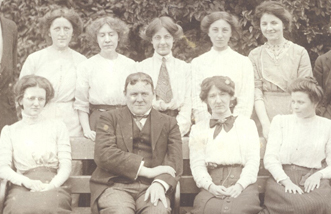| Thematic History | |||||
| Women at Queen Mary Online: a virtual exhibition | |||||
 |
|||||
| In this section: | Learning at East London College | ||||
|
> 1850-1901: > 1902-1913: > 1914-1945: > 1946-1959: > 1960-present: |
|||||
East London College offered men and women a range of courses, which were mainly vocational in nature. These included subjects ranging from plumbing, book-keeping and elocution, to dressmaking, millinery and house decoration. Other, more academic, subjects were also offered, including mathematics, botany, art and literature. Women students predominately studied arts-related subjects and those that would fit them well for their 'vocation' in the home. Those courses traditionally associated with women’s roles proved very popular with women students, thereby reinforcing the traditional male and female roles. However, many women students excelled amongst their male counterparts in a range of challenging academic subjects. Pictured right is Miss Gladys A. Moore (front row, second from right), who took a Masters in Education after studying at East London College. She later worked as an Assistant Mistress teaching English in girls grammar schools in Chatham and Brecon. She became Head Mistress at Brecon and the first Head of South Wilts County Girls School, where she remained until her retirement in 1953.
At East London College, the local working-class population were given greater access to education, libraries and opportunities for improvement, which might offer them the possibility of social mobility. Students were aware of such challenges, and were active in debating these and other social issues of the day, including The Conciliation Bill and Women's Suffrage. The Conciliation Bill was put forward in June 1910 by an All Party Committee of MPs to give some women the vote. The Bill was passed by the House of Commons, but then dropped when another election was called in November. Two more Conciliation Bills were attempted in Parliament in the subsequent years. Furious suffragettes stepped up their campaign resulting in many clashes with police and arrests. More... |
| << previous | Explore the Thematic History |
|



